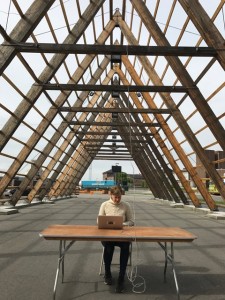ELAPSES, sound installation, 24 min, the Arctic Pyramid at SALT, OSLO July-December 2017 First version of this work was shown at IL SUONO IN MOSTRA, UDINE, ITALY, 03.07.2017-11.07.2017.
A conversation on ELAPSES by Signe Lidén for the Arctic Pyramid in SALT
Shortly after the seed vault opened in 2008, the artist Signe Lidén was invited to do a project using the Svalbard Global Seed Vault as its focal point. In this conversation with Hilde Methi and Britt Kramvig, who are curating art and debates in SALT, she reflects upon her encounters with the seed vault and how it has informed her new work, Elapses, in SALT.
SALT: Svalbard Global Seed Vault is located on the remote island of Spitsbergen in the Arctic. Here local seeds from seed banks around the globe are stored to provide insurance against extinction in case of large scale catastrophes. Could you describe the place?
Signe Lidén: The facility resides a 120 meters long tunnel into the mountain 130 meters above the sea level. It opened on a site considered the safest and most stable. It was built to guarantee stable permafrost and avoiding rising sea level as a result of global warming, nuclear attack, and earthquakes. Today, less than 10 years later we have learned that there is no site that hold as secure and stable. The technological devices struggle to monitor and keep the temperature stable – as well as keeping the melt water out of the vault.
SALT: Do you recall what were the most interesting aspects of your exploration on the seed vault?
SL: I became fascinated by the long term thinking embedded in the very idea of the vault. It occurred to me that we seem to lack a language for the unspecified future that stretches into eternity. This is also what has informed my work on Elapses.
SALT: So, it is the distance between an intense present, with climatic challenges and an elusive future hiding beyond the horizon that Elapses attends to?
SL: Yes, I asked myself the following: if we would develop the vocabulary of long term thinking, do we become more capable of taking responsible actions for a sustainable future both as individuals and society? If so, how? Perhaps by developing a language which primarily speaks from and to the senses, to what we can call a sensing-knowing – or body-knowing. Challenged by this thought, I figured that listening to the seed vault could be a good place to start.
SALT: When we are listening to the piece, one thinks of the effort done by both human and technological devices to keep the seeds intact. How did you work with the composition?
SL: The compositional idea is to approach the seed vault as a body being examined; its veins, pulses and operating systems. With stethoscope, contact microphones, hydrophones and binaural microphones we are listening to the vault´s chambers and it´s machinery: The crackling of the ice on the door to the chamber where the the seeds lie in hibernation. The mechanic pump pumping melt water, the freezer, the ventilation, the control room. And inside the railings: the vault´s echoes.
SALT: It appears as a melancholic place, to which nations are bringing their seeds of their redlisted orchids and essential food plants. The act of storing duplicates of our most valuable seeds in a protected vault into the future creates an idea of a future reality where those same species are gone. Your piece is somewhat addressing a process of civilisation struggling and failing of holding on to the control over natures and futures?
SL: I like to rather think about the seed vault as a place from where we could start developing new tools in order to comprehend and act more responsible in relation to the future. The vault offers an example of a site where the future of eternity can be embodied and sensed as real. Another aspect of time is embedded in the seeds of the food crops themselves. One could consider them as our capsulated memory or markers of the in-between space of what has past and what will come.
